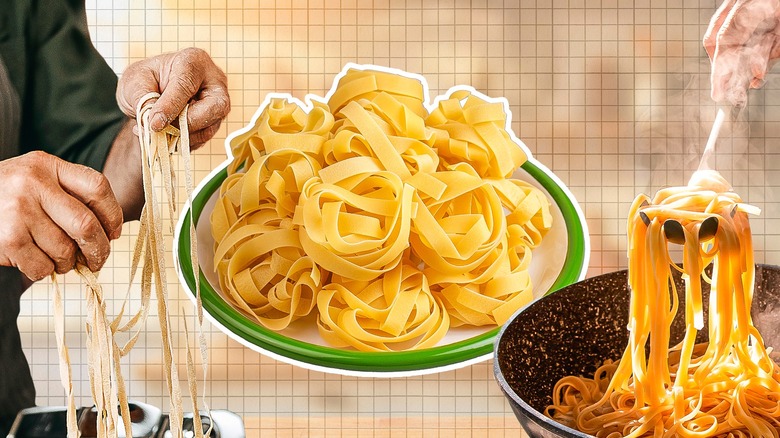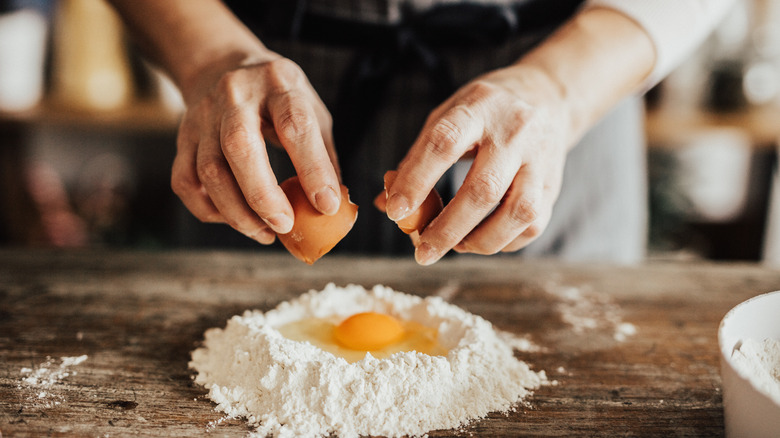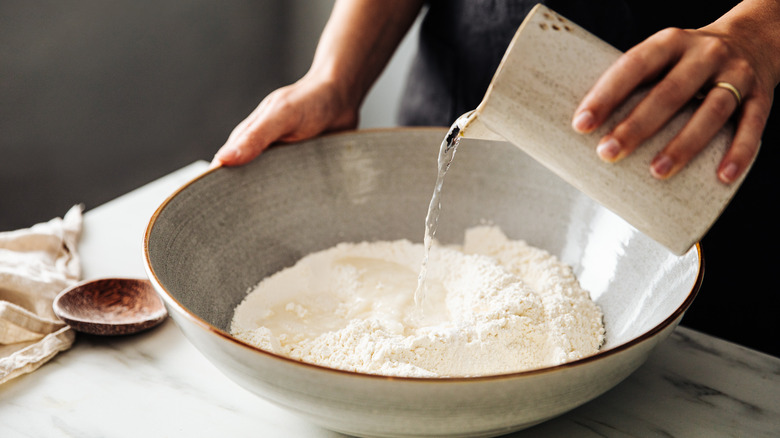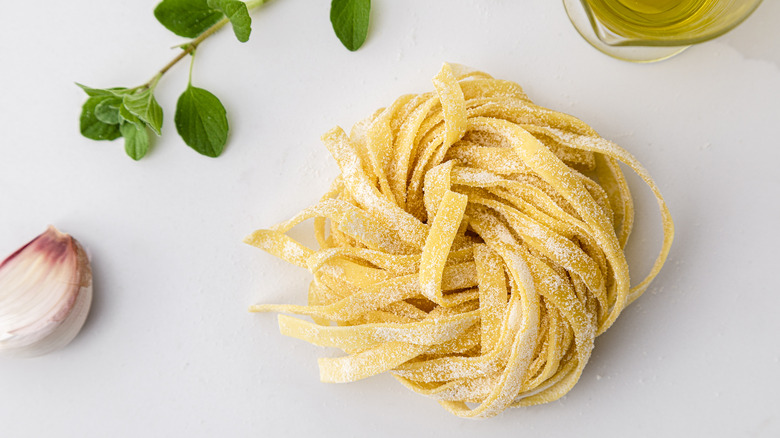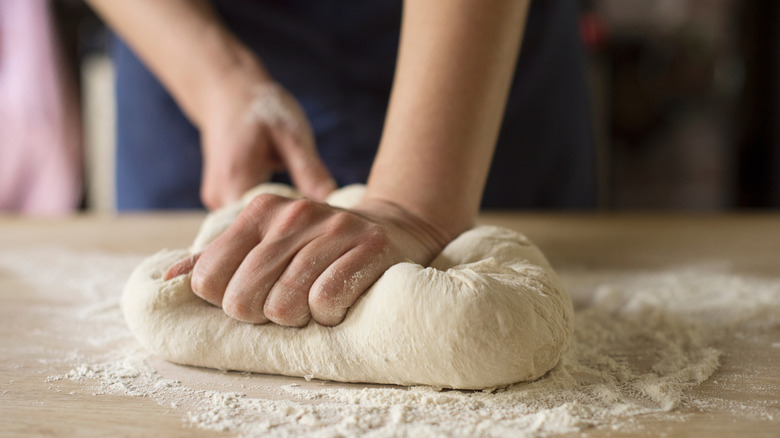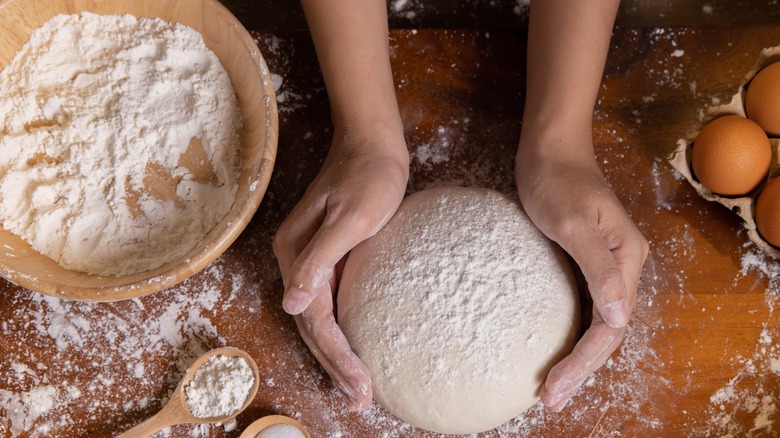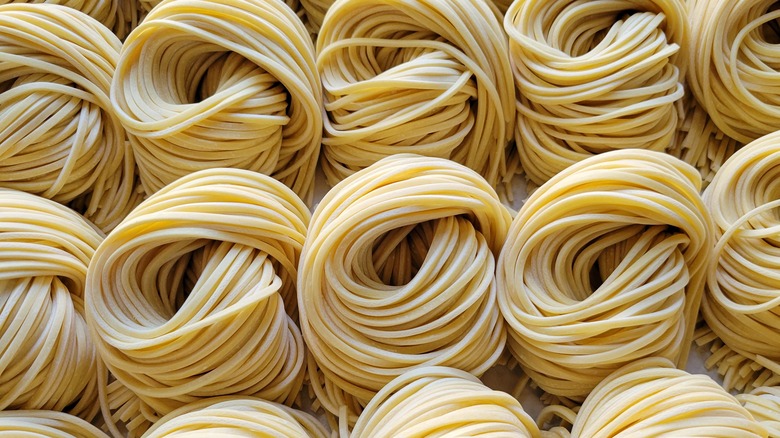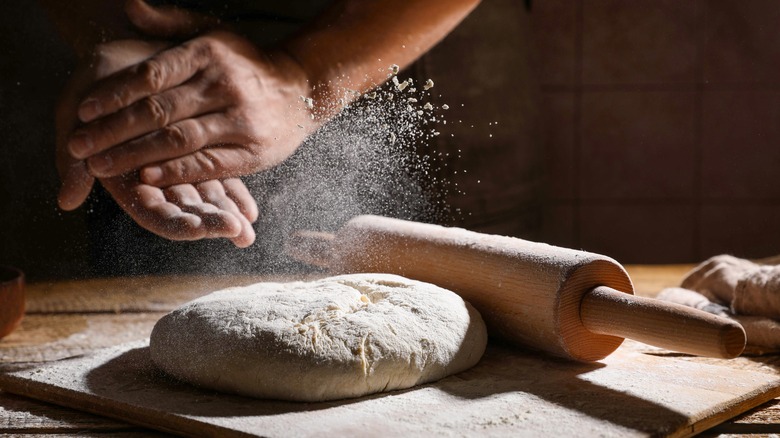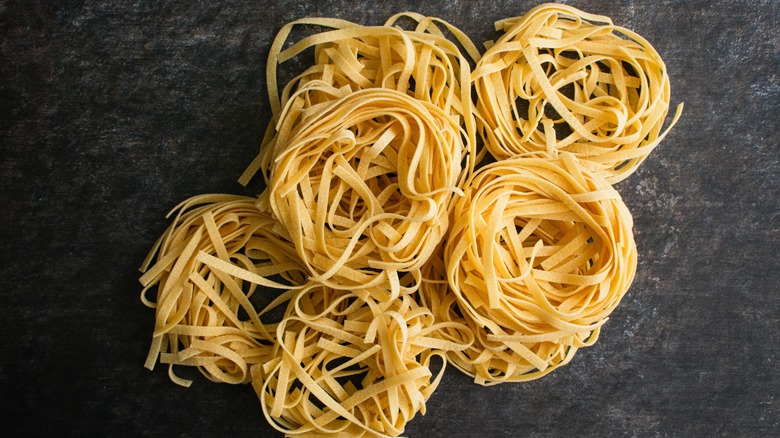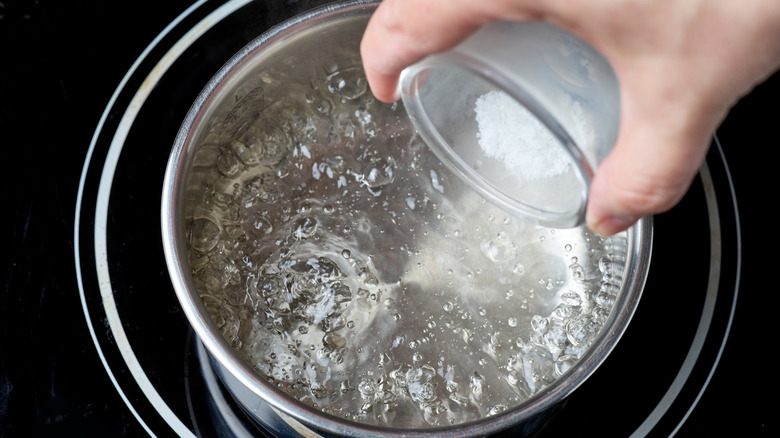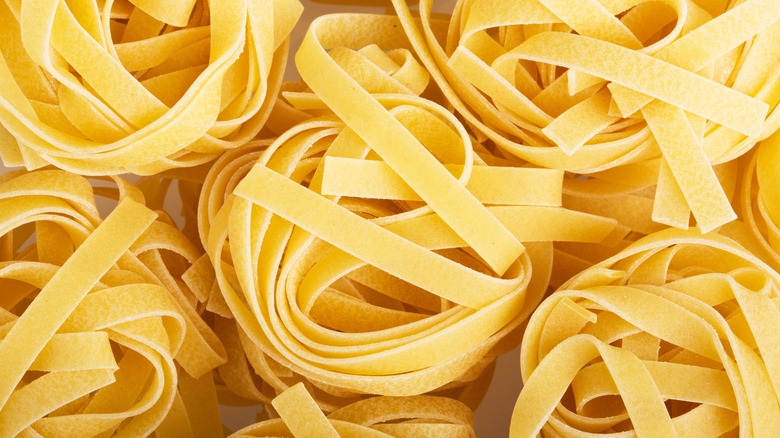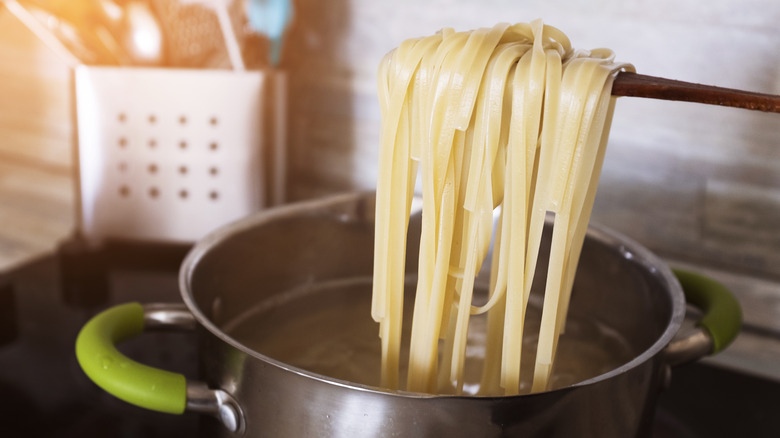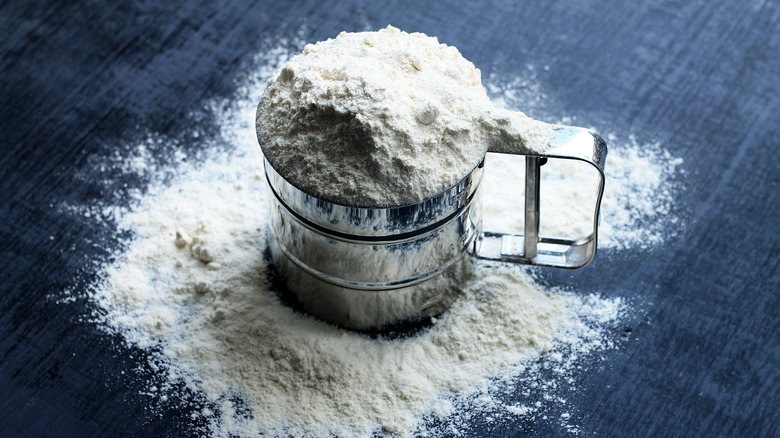Chef-Recommended Tips For Making Homemade Egg Noodles
Nothing's better than a fresh batch of homemade pasta. The taste and texture of freshly prepared noodles is well worth the time spent making them, particularly when it comes to the versatile egg noodle. Unsurprisingly, the main difference between egg noodles and other types of pasta is that egg noodles (true to their name) use more egg than other varieties, giving them a richer taste and heavier texture.
While many cuisines use egg noodles with creamier and more flavorful sauces, they can fit any type of dish you want — and you don't even have to change the noodle recipe. On that note, it's actually fairly simple to learn how to make this type of pasta from scratch on your own. And once you learn the tips for making homemade egg noodles, you may never go back to dried pasta again.
To get the best recommendations for making homemade egg noodles, we spoke to Travis Post, chef and co-owner of the Seattle, Washington restaurant Noodle/Bar. Post handmakes all the noodles for the restaurant in house, so he knows the best ways to create delicious homemade egg noodles. If you're ready to improve your pasta preparation abilities with expert insight, here are some tips to know when it comes to making homemade egg noodles.
Adjust the amount of egg to change the texture
Since everyone's preferences are different when it comes to fresh pasta, you may need to slightly adjust the basic recipe when you first start preparing fresh noodles until you get what you're going for. After all, adjusting the amount of eggs in your recipe can yield a different style of noodle, according to Travis Post.
"The more you increase the egg, the more homestyle noodle you'll get," Post told Tasting Table. "Like the kind my grandmother rolled out on her Midwest dining table several nights a week." There are a few different options for egg adjustments when it comes to egg noodles. You can increase the number of whole eggs used or divide the eggs instead.
Adding more yolks, for example, will provide your noodles with a richer taste and color. Incorporating more egg whites, on the other hand, will change the texture of the dough (and can potentially make it tackier, too). Given this, you may want to make several small batches of noodles with different egg ratios when first starting, particularly if you've got a strong personal preference.
Be sure to add water to your dough
Many recipes debate over whether or not to use water in egg noodles. Some prefer to use the egg itself as the only form of moisture, while others call for small amounts of water to make it easier to mix the dough. While it's true that egg noodles include more eggs than a standard pasta recipe, that doesn't necessarily mean that you should pass on the water entirely.
Travis Post recommends starting with a ratio of half egg and half water to achieve the proper balance for homemade egg noodles. This will help the dough mix together more easily without sacrificing the texture or structure of the noodles. If your dough becomes too wet, it can lose its structural integrity, and you won't be able to cut it or properly shape it into noodles.
Keep in mind: It's normal for pasta dough to be difficult to mix together at first. In fact, as Post said, "When you first mix the dough, it should almost feel too dry." However, after resting for a while, it will gradually become easier to knead. In other words, don't assume you need to add more liquid right away if your dough isn't immediately coming together as intended.
Knead your dough twice for the best results
Kneading pasta dough by hand is one of the best strategies for making fresh egg noodles. But Travis Post suggests kneading the dough two separate times — and letting it rest for 10 to 15 minutes between kneading — before rolling it out.
The reason for this is that resting the dough can actually speed up the overall kneading process. While resting, the gluten in the dough will actually expand, which does a lot of the work for you. This will then cut down on the time you need to spend actively kneading and make the dough easier to handle once you're ready to start again.
Once the dough has begun to form into a ball, let it rest (by placing it in a bowl, covering it, and leaving it out on a counter) for a period. Of course, you won't need to spend much time kneading the second time around. Post notes an additional three minutes should suffice, and will help ensure the highest-quality texture for your egg noodles once cooked.
Prepare your noodles by hand
Believe it or not, many actually prefer to mix and knead pasta dough by hand instead of using a stand mixer. When you mix dough by hand, you may find it's easier to ensure all the ingredients are properly mixed together; a mixer isn't always great at picking up loose flour and combining it with the rest of the dough, for example. You can use a combination of both techniques if you prefer, as well, but making the best homemade egg noodles requires some kneading by hand.
One option is using a mixer to initially combine the ingredients. This helps quickly blend everything together and can save you a bit of work. Since the dough may end up getting a little too tough for the stand mixer once the ingredients have been mixed, it's preferable to continue kneading by hand at this point (and is the reason why many people prefer kneading exclusively by hand). If you do choose to use a stand mixer, whatever you do: Don't add extra water or eggs to help the kitchen appliance, as you'll likely just end up ruining your noodle dough in the process.
Rest your noodles for the best dough
There's one key step you can't miss when making fresh pasta: resting your dough. This will lead you to the best results in terms of pasta structure and will even help you cut down on kneading time. If you don't relax your dough at all, you'll find it may end up too difficult to roll out or cut. Travis Post recommends resting your dough between each step of the preparation process, with a longer rest period before you're ready to roll out your dough.
As Post told us, "Resting the dough 1 to 24 hours before rolling is your secret weapon." Allowing proper time to rest will give the gluten enough time to expand and give your dough the perfect texture, while making the dough much easier to roll out, as well. This also gives you some extra time out of the kitchen if you want to prepare your pasta dough ahead of time (since you can rest egg noodle pasta dough for an entire day if needed).
Of course, anything longer than 24 hours could cause your pasta dough to go bad. Given this, once your dough is mixed, don't wait too long to roll it out or cook the noodles.
Know what noodle shape you need
When making egg noodles at home, the easiest way to cut the pasta dough is with a pasta cutter or knife. However, the shape your egg noodles take will likely vary based on the type of dish you're preparing. So how do you know whether you should cut thin or thick strips? Well, the noodle shape typically relates most to the sauce you're dressing your dish with.
At Noodle/Bar, one dish in which Travis Post uses egg noodles is in a broth with braised pork. He opts for thinner, straight egg noodles that you might find in traditional Chinese noodle soups for such an item. Thicker noodles, on the other hand, will typically be used for heavier dishes. The thicker the noodle, after all, the thicker the pasta sauce is likely to be.
Generally, you're likely to find egg noodles being cut into two main shapes: Very wide noodles that are good for heavy soups and pasta dishes, or very thin noodles that you might find in lighter broths or dishes with thinner sauce. These are good pasta shape guidelines to follow when you're cutting homemade egg noodles. Of course, personal preference matters, too — you might find that you enjoy one shape over the other when it comes to egg noodles regardless of the dish itself.
Add a layer of flour before cutting your noodles
If your noodles are sticking together while you're cutting them, rolling them, or cooking them, there's an easy way to prevent this: add a little flour to the surface of the dough. A layer of flour can help prevent the noodles from sticking as you cut or roll them into shape. Now, this doesn't mean you should be kneading this layer of flour into the dough. Rather, it needs to stay on the surface of the rolled dough as you cut the noodles into shape, as the flour is there to prevent the noodles from sticking to each other or to your cutter.
Furthermore, adding flour to the surface of your dough can help prevent the noodles from sticking together while they cook, too. If you're looking to be extra cautious, you can even add a little extra sprinkling of flour to your noodles before cooking them. As the noodles are boiled, the flour will come off of the noodles and into the pasta water, so you don't need to worry about flour remaining on the surface of the noodles once they're done cooking.
Store your noodles properly if not cooking them immediately
The best part of homemade pasta may be the freshness of its flavor and texture. If you're looking for the freshest noodles possible, you'll need to start boiling the water while you're rolling out your pasta dough — at least according to Travis Post. "Don't cut until your water is boiling," Post said, so you can start to cook the noodles as soon as they're sliced.
Now, maybe you're hoping to make a huge batch of noodles to enjoy for the rest of the month. In that case, you'll need a good way to store fresh pasta noodles over time, and there are some easy methods to do this. First, cut your noodles to your desired shape and dust them with flour. Then, you can bundle them together (which is what Post does when he prepares large batches of fresh noodles for Noodle/Bar). You can store fresh pasta in an airtight container in the fridge for up to a day after it's been cut.
Another simple way to store fresh pasta without compromising much of its quality is to put it in the freezer instead, where it can keep for up to two months. If you want to keep your homemade egg noodles in the pantry, you can even dry them by laying the noodles out or hanging them for about 12 hours; once they're dry, they'll keep for a few months.
Salt your pasta dough and cooking water
Some egg noodle recipes don't call for any seasoning, but salting your dough is an easy way to make your noodles more flavorful. Many chefs agree that pasta tastes better when the dough has a bit of salt in it, including Travis Post, who uses just a pinch of salt in his recipe.
Now, salting the dough doesn't mean you can skip out on salting the water, too. After all, the main reason to add salt to boiling water before cooking pasta is because the water can help add extra flavor to your noodles (and it's easy to control the salt level depending on the type of dish you're making).
Even better, salting your pasta water can help prevent the noodles from sticking together while they cook, too. As your pasta boils, the starches from the dough begin to release into the water. However, salted water can help prevent the starch from sticking together as it cooks, allowing your noodles to boil perfectly without issue every time.
Know how to make noodle nests
One of the best ways to store (and then cook) egg noodles is by turning them into nests. Nests provide a simple way to keep your pasta in the fridge or freezer, and you can even dry it in nests, too. This technique also makes it easier to portion and cook the noodles later. After all, one nest generally equals one serving — so you'll always have the right amount of noodles for the number of diners.
There are varying techniques for making noodle nests, but most start with the basics. To nest your noodles, take a portion of freshly cut noodles, and hold them in the center. Take your other hand and gather the bottoms of the noodles together, before laying it down in a circle. This will leave you with an egg noodle nest that's ready to drop into boiling water, or store for later in an airtight container.
If your noodles are sticking together too much for you to form a proper nest, you may want to dust them lightly with flour before forming the noodle nests. This will help keep your noodles separate while they're in the nest — and separate when you finally cook them, as well.
Don't overcook egg noodles
Wondering how long homemade noodles need to stay in the pot and cook before they're ready to serve? Well, according to Travis Post, egg noodles only require 2 to 4 minutes of cooking on average "depending on the hydration level and thickness." If your noodles are very thin, for instance, they'll only need a couple of minutes in the pot, while thicker noodles may take up to 4 minutes.
If this sounds like a shorter than expected timeframe to cook noodles, you're not wrong — at least when it comes to boxed pasta. Fresh pasta, however, cooks much faster. With that in mind, be sure to wait until the water is boiling before dropping in your noodles; pasta cooking times are determined by how long the noodles have been in boiling water, after all.
With homemade egg noodles, it's important to watch them carefully to ensure they don't overcook. They're usually ready once the noodles begin to rise to the surface of the boiling water, though the best way to test your egg noodles to make sure they're done is to taste one. Once your noodles are tender but still chewy, they're ready to be removed from the boiling water (and if your noodles have successfully reached this state, congratulations!).
Use certain types of wheat flour for noodles
If you're making egg noodles, you probably already know you'll need to use wheat flour. It contains the necessary gluten that gives your noodle dough its texture and structure, after all (and, contrary to the name, egg noodles aren't gluten free). Not all wheat flours are the same, though, and one of the best options when making pasta is semolina flour, which is made from durum wheat.
Semolina flour has a higher gluten content than many other flour varieties. This makes the noodle-making process easier while helping your dough remain less sticky (or tough to knead). It ensures your noodles hold their shape while they're being cooked, and the texture of semolina flour can even help pasta sauce better stick to the noodles.
But semolina isn't the only flour option when it comes to making egg noodles. This is good, of course, since you're probably more likely to have another flour alternative in your pantry already. All-purpose flour is a great option for homemade egg noodles, for example. It's often used in egg noodle recipes because it's a fantastic way to create the firm-yet-tender pasta texture — which is Travis Post's hallmark of a perfect egg noodle.
